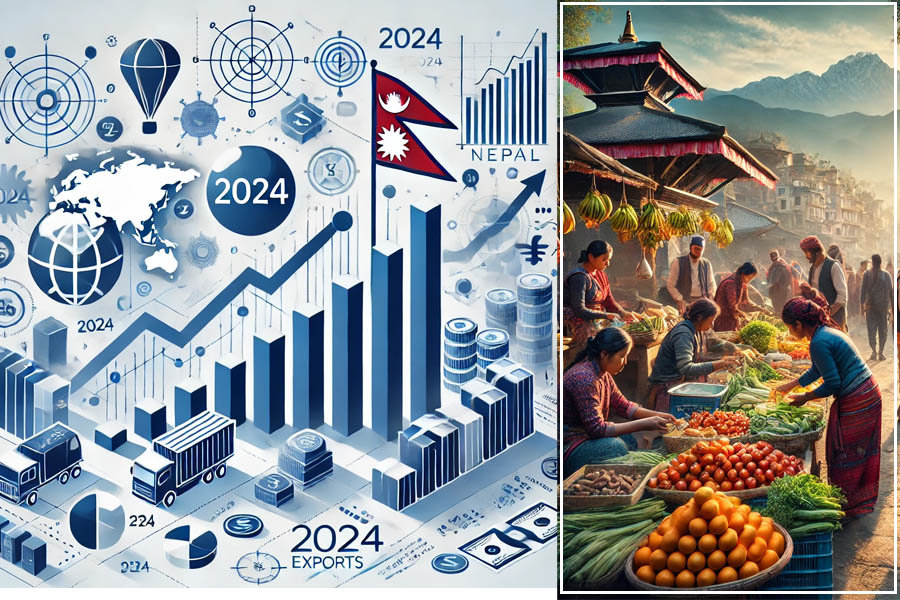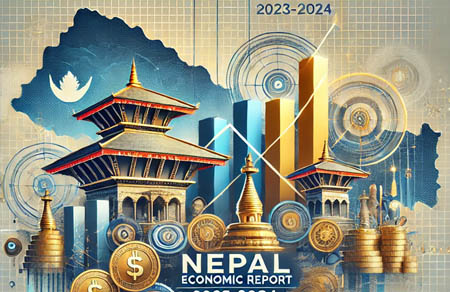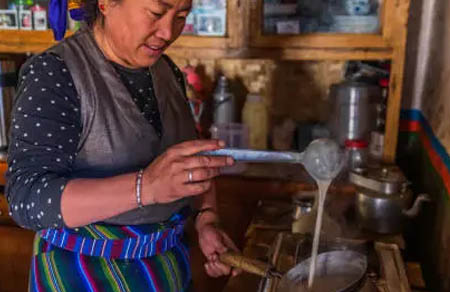
Nepal Economy Update 2024: Inflation, Remittances, and Foreign Trade Performance
December 22, 2024Nepal's economy, in the period leading up to mid-November 2024, has shown a resilient yet nuanced performance, navigating through inflationary pressures, external trade challenges, and fluctuating remittance inflows. While consumer price inflation remains steady at 5.60%, reflecting the delicate balance of rising food prices and subdued non-food costs, the country has witnessed promising growth in its foreign trade, with exports rising by 4.2% and imports by a modest 0.2%. Remittances, the lifeblood of many households, saw a healthy 9.1% increase in Nepali Rupee terms, cushioning the effects of global economic uncertainty. However, as Nepal continues to navigate these dynamic economic shifts, it is clear that strategic financial management and external sector adaptability will play pivotal roles in determining the sustainability of this growth in the months ahead.
Major Highlights
- Consumer Price Index (CPI)-based inflation stood at 5.60% year-on-year.
- Imports and exports grew by 0.2% and 4.2% respectively.
- Remittances surged by 9.1% in NPR terms.
- Balance of Payments remained in surplus, amounting to Rs.205.83 billion.
- Gross foreign exchange reserves rose to USD 16.70 billion.
- Government expenditure reached Rs.415.02 billion, with revenue collection of Rs.323.24 billion.
- Broad money (M2) expanded by 3.0%, with a year-on-year growth of 12.1%.
- Deposits in banks increased by 2.3%, while private sector credit grew by 2.5%.
Inflation Trends
The Consumer Price Index (CPI) for the year ending mid-November 2024 registered a modest rise of 5.60%, reflecting a slight uptick from last year's figure of 5.38%. This inflationary trend is driven by a surge in food prices, which increased by 9.10%, while non-food inflation remained subdued at 3.65%.
Food and Beverage
The price of essential food items like vegetables, pulses, and ghee rose sharply. Notably, the price of vegetables soared by 33.99%, while pulses saw a 10.78% increase. Interestingly, some food categories such as spices and sugar experienced slight deflation, with declines of 1.41% and 1.28%, respectively.
Non-Food and Services
Non-food inflation, though moderate, was propelled by increases in miscellaneous goods, alcohol, clothing, and tobacco. The price index for miscellaneous goods and services shot up by 10.41%, indicating inflationary pressures in everyday goods and services.
Rural vs Urban Inflation
Rural areas experienced a higher inflation rate of 6.19%, contrasting with 5.39% in urban areas, further highlighting regional disparities in price changes.
External Sector Overview
Trade Performance
Merchandise exports showed a growth of 4.2%, reaching NPR 52.67 billion. However, imports remained largely stagnant, growing by just 0.2%, amounting to NPR 513.39 billion. This resulted in a marginal decrease of 0.3% in the trade deficit, which now stands at NPR 460.72 billion.
Key Exports
Exports to India, Nepal's largest trading partner, saw an increase of 8.4%, whereas exports to China and other countries experienced declines of 18.3% and 3.0%, respectively. Key products like soybean oil, tea, and polyester yarn showed significant growth, whereas exports of palm oil, zinc sheets, and garments saw a decline.
Remittance Inflows
Remittances, a key pillar of Nepal's economy, grew by 9.1% to Rs.521.63 billion in the review period. This increase, however, was slower compared to last year’s growth rate of 22.5%. The remittance sector remains a vital source of foreign currency, helping to offset the trade deficit and stabilize the balance of payments.
Foreign Exchange Reserves
Gross foreign exchange reserves rose by 10.5%, reaching NPR 2255.35 billion by mid-November 2024. In USD terms, this equates to USD 16.70 billion. These reserves are crucial in covering the country’s import bills, with the current reserves sufficient to cover 18 months of prospective merchandise imports.
Foreign Exchange Adequacy
The foreign exchange adequacy indicators suggest a healthy buffer, with reserves-to-imports ratio standing at 126% and reserves-to-GDP ratio at 39.5%. These figures point to Nepal's growing ability to manage external shocks and safeguard economic stability.
Viewpoints and Conclusion
The current macroeconomic indicators present a mixed picture for Nepal. On the one hand, positive trends in remittances, foreign exchange reserves, and government revenue provide optimism for continued economic stability. On the other hand, inflationary pressures, particularly in food prices, remain a concern, particularly for rural areas.
The slight increase in exports, despite a trade deficit, is a positive sign, but Nepal’s economy must diversify its export base and reduce dependency on imports to achieve sustainable growth. The government's expenditure and revenue collection efforts will be crucial in maintaining fiscal health and addressing any emerging economic challenges.
Ultimately, while Nepal’s economy is showing resilience in the face of global economic uncertainties, careful management of inflation and external trade imbalances will be essential to ensuring long-term economic prosperity.
Source: Based on Four Months Data Ending Mid-November, 2024/25 Published by Nepal Rastra Bank Economic Research Department, Baluwatar, Kathmandu
Explore Nepal’s Economic Challenges and Opportunities
While the slight rise in exports offers a glimmer of hope, Nepal faces the pressing need to diversify its export portfolio and reduce reliance on imports to foster sustainable economic growth in FY 2024/25.
Subscribe for Expert Economic InsightsGet the latest updates and expert commentary on Nepal's evolving economy and its impact on global trade.
Read More From Us
- 🌟🌟🌟🌟🌟 For more International Breaking News visit us at International News
- 🌟🌟🌟🌟 For More Russia-Ukraine War updates, click here
- 🌟🌟🌟🌟🌟 For more International Trade Business news, hit here
Tags: #NepalEconomy2024 #InflationInNepal #RemittanceGrowth #ForeignTradeNepal #EconomicTrends #NepalEconomicUpdate #GlobalEconomy #EconomicPerformance #NepalFinance #SustainableGrowth #GlobalPostHeadline
Thank you for reading: globalpostheadline.com





